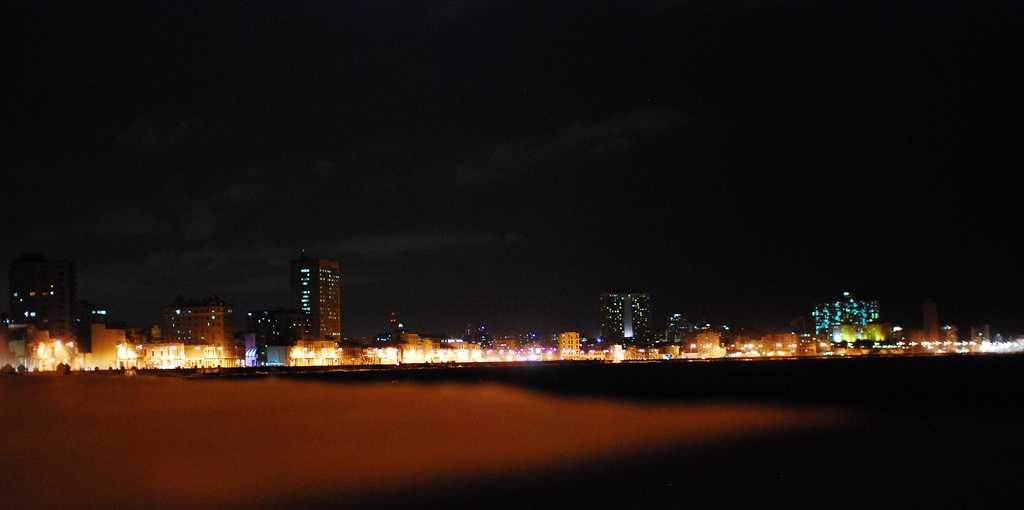
View of the Malecon in Havana all lit up. Photo by Paul Keller licensed Creative Commons Attribution.
Officially known as Avenida Antonio Maceo, and more properly the Muro de Malecón (literally “embankment,” or “seawall”), Havana’s seafront boulevard winds dramatically along the Atlantic shoreline between the Castillo de San Salvador de la Punta and the Río Almendares. The six-lane seafront boulevard was designed as a jetty wall in 1857 by Cuban engineer Francisco de Albear but not laid out until 1902, by U.S. governor General Woods. It took 50 years to reach the Río Almendares, almost five miles to the west.The Malecón is lined with once-glorious high-rise houses, each exuberantly distinct from the next. Unprotected by seaworthy paint since the Revolution, they have proven incapable of withstanding the salt spray that crashes over the seawall in great airy clouds and then floats off in rainbows. Many buildings have already collapsed, and those that were painted in haste for the pope’s visit in 1998 have faded again. An ongoing restoration seems to make little headway against the elements, although wrought-iron street lamps in classical style have gone up.
All along the shore are the worn remains of square baths—known as the “Elysian Fields”—hewn from the rocks below the seawall, originally with separate areas for men, women, and negros. These Baños del Mar preceded construction of the Malecón. Each is about four meters square and two meters deep, with rock steps for access and a couple of portholes through which the waves wash in and out.
The Malecón offers a microcosm of Havana life: the elderly walking their dogs; the shiftless selling cigars and cheap sex to tourists; the young passing rum among friends; fishermen tending their lines and casting off on giant inner tubes (neumáticos); and always, scores of couples courting and necking. The Malecón is known as “Havana’s sofa” and acts, wrote Claudia Lightfoot, as “the city’s drawing room, office, study, and often bedroom.” All through the night, lovers’ murmurings mingle with the crash of the waves.
The Malecón—the setting for spontaneous riots in the early 1990s—is also a barometer of the political state of Havana. During times of tension, the police presence is abnormally strong and the Malecón becomes eerily empty.
Every October 26, schoolchildren are bused here to throw flowers over the seawall in memory of revolutionary leader Camilo Cienfuegos, killed in a mysterious air crash on that day in 1959.
Dominating the Malecón to the west, at the foot of Avenida Padre Varela, is the massive bronze Monumento Antonio Maceo, atop a marble base in a plaza with a fountain. The classical monument was erected in 1916 in honor of the mulatto general and hero of the Wars of Independence who was known as the “Bronze Titan.” The motley tower that stands at the west end of the plaza is the 17th-century Torreón de San Lázaro, with loopholes for snipers aiming along the Malecón. Although it looks fairly modern, it was built in 1665 to guard the former cove of San Lázaro.
To the south, the Hospital Hermanos Almeijeiras looms over the park. The Convento y Capilla de la Inmaculada Concepción (San Lázaro #805, e/ Oquendo y Lucena, tel. 07/878-8404, Mon.–Sun. 9 a.m.–5 p.m.) is immediately west of the hospital. This beautiful church and convent was built in Gothic style in 1874 and features notable stained-glass windows and a painted altar.
Excerpted from the Fifth Edition of Moon Cuba.